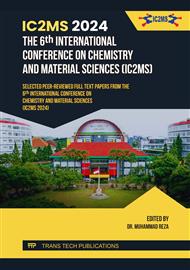[1]
Dompeipen, E. J., Kaimudin, M., Dewa Balai Riset dan Standarisasi Industri Ambon, R. P., Cengkeh, J., & Merah Ambon, B. (2016). Isolation Of Chitin And Chitosan From Waste Of Skin Shrimp. Majalah Biam, 12(1): 32-38.
Google Scholar
[2]
Sowmya, R., Ravikumar, T. M., Vivek, R., Rathinaraj, K., & Sachindra, N. M. (2014). Optimization of enzymatic hydrolysis of shrimp waste for recovery of antioxidant activity rich protein isolate. Journal of Food Science and Technology, 51(11), 3199–3207
DOI: 10.1007/s13197-012-0815-8
Google Scholar
[3]
J. Ferrer a, (1996). Acid hydrolysis of shrimp-shell wastes and the production of single cell protein from the hydrolysate. Bioresource Technology, 57(1), 55– 60.
DOI: 10.1016/0960-8524(96)00057-0
Google Scholar
[4]
Singh, S.M., R.B. Siddhnath, A. Aziz, N. Verma & B.B. Chriwatkar. 2018. Shrimp waste powder: Potential as protein supplement. Int. J. Pure Appl. Biosci. 6. 401-406
DOI: 10.18782/2320-7051.7141
Google Scholar
[5]
Petrova, I., Tolstorebrov, I., & Eikevik, T. M. (2018). Production of fish protein hydrolysates step by step: technological aspects, equipment used, major energy costs and methods of their minimizing. In International Aquatic Research (Vol. 10, Issue 3, p.223–241). Springer Verlag
DOI: 10.1007/s40071-018-0207-4
Google Scholar
[6]
Gao et al. 2024. Advances in extraction, utilization, and development of chitin/chitosan and its derivatives from shrimp shell waste. Comprehensive Reviews in Food Science and Food Safety Volume 23, Issue 5
DOI: 10.1111/1541-4337.70008
Google Scholar
[7]
Kristinsson, H. G., & Rasco, B. A. (2000). Fish protein hydrolysates: Production, biochemical, and functional properties. Critical Reviews in Food Science and Nutrition, 40(1), 43–81
DOI: 10.1080/10408690091189266
Google Scholar
[8]
Irazoqui, J.M., et al. 2024. Enzymes for production of whey protein hydrolysates and other value-added products. Applied Microbiology and Biotechnology 108: 354
DOI: 10.1007/s00253-024-13117-2
Google Scholar
[9]
Gildberg A, Stenberg E (2001) A new process for advanced utilizationof shrimp waste. Process Biochem 36:809–812
DOI: 10.1016/s0032-9592(00)00278-8
Google Scholar
[10]
Kristinsson HG, Rasco BA (2000) Biochemical and functional properties of Atlantic salmon (Salmo salar) muscle hydrolyzed with various alkaline proteases. J Agric Food Chem 48:657–666
DOI: 10.1021/jf990447v
Google Scholar
[11]
Evangelho, J. A. D., et al. (2017). Black bean (Phaseolus vulgaris L.) protein hydrolysates: Physicochemical and functional properties. Food Chemistry 214: 460–467
DOI: 10.1016/j.foodchem.2016.07.046
Google Scholar
[12]
Helen Helda Prastika., et al. (2019). Penggunaan Enzim Pepsin Untuk Produksi Hidrolisat Protein Kacang Gude (Cajanus cajan (L.) Millsp.) Yang Aktif Antioksidan. Cakra Kimia (Indonesian E-Journal of Applied Chemistry) , 7(2), 180–188
Google Scholar
[13]
Sjaifullah, A., & Santoso, A. B. (2016). Autolytic Isolation of Chitin from White Shrimp (Penaues Vannamei) Waste. Procedia Chemistry, 18, 49–52
DOI: 10.1016/j.proche.2016.01.009
Google Scholar
[14]
Juniarso, E. T. (2008). Pemanfaatan Ekstrak Kasar Protease Dari Isi Perut Ikan Lemuru (Sardinella sp.) Untuk Deproteinasi Limbah Udang Secara Enzimatik Dalam Proses Produksi Kitosan. Skripsi.
Google Scholar
[15]
Rosaini, H., Rasyid, R., & Hagramida, V. (2015). Penetapan Kadar Protein Secara Kjeldahl Beberapa Makanan Olahan Kerang Remis (Corbiculla moltkiana Prime.) DARI DANAU SINGKARAK. In Jurnal Farmasi Higea (Vol. 7, Issue 2).
Google Scholar
[16]
Bradstreet, R.B. 1954. Kjeldahl Method for Organic Nitrogen. Analytical Chemistry 26 (1): 185-187
DOI: 10.1021/ac60085a028
Google Scholar
[17]
Wijayanti, T. (2022). Teknik dan Metode Analisis Biokimia. Media Nusa Creative.
Google Scholar
[18]
Silman H., & Karlin, A. (1967). Effect Of Local Ph Changes Caused By Substrate Hydrolysis On The Activity Of Membrane-Bound Acetylcholinesterase. Proc Natl Acad U.S.A 58(4): 1664-1668
DOI: 10.1073/pnas.58.4.1664
Google Scholar
[19]
Shahidi, F. and M. Naczk. (1995). Food Phenolics : Sources, Chemistry, Effects, and Applications. Technomic Publishing Company. USA
DOI: 10.1016/s0308-8146(96)80478-x
Google Scholar
[20]
Puspitasari, G., Safrihatini, W., & Umam, K. (2019). Studi Kinetika Reaksi Dari Enzim α-Amilase Pada Proses Penghilangan Kanji Kain Kapas. Arena Tekstil, 34(1):1-6.
DOI: 10.31266/at.v34i1.5097
Google Scholar
[21]
Jeyaprakashsabari, S., & Aanand, S. (2021). Shrimp Waste – A Valuable Protein Source for Aqua Feed. AgriCos e-Newsletter 2(7): 64-67
Google Scholar


